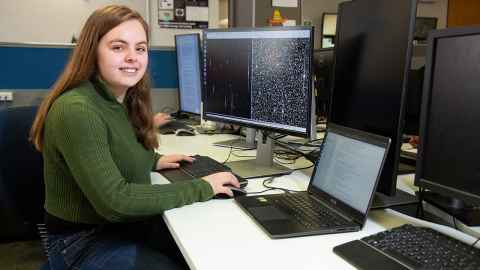Astronomy, astrophysics and asteroids
9 December 2019
For Amelia Cordwell, the symbiosis between a curious mind, a thirst for learning, and exposure to research has created an enduring love and respect for physics and the scientific study of space.

Amelia is in her third year of a Bachelor of Science in Physics, and she thinks space is ‘cool’. It’s an expression she uses a lot when talking about the astrophysical research world she now occupies. An expression which seemingly belies the complexity of space and humankind’s fixation on our ‘final frontier’ throughout the ages. The study of space creates more questions than answers. And yes, it is very, very cool.
Amelia’s interest in space has been a slow burn from her teenage days in Wellington when she planned to become a software developer and occasionally attended events at the Wellington Astronomical Society (WAS).
Before Amelia passed her driver’s licence, her mum would transport her, a friend, and a large telescope lent to them from the WAS, up to Mt Victoria where they would gaze at the night sky just for fun.
After a semester studying Engineering at the University of Auckland, back home in Wellington, Amelia realised she wanted to study physics to broaden her education.
“I got a summer internship as a software developer, and I thought, 'This is fun, but there is so much more I want to learn, '” she says. “I changed my focus to physics because it’s so expansive and you develop really interesting ways of thinking about the world. I decided to get involved in a bunch of things at uni and try out everything I can.”
Once Amelia’s focus zeroed in on physics, and having been accepted into the Science Scholars programme at the Faculty of Science, the world of research beckoned.
But it was while taking part in the Auckland Programme for Space Systems (APSS) undergraduate CubeSat competition that Amelia met Dr Nick Rattenbury, Senior Lecturer at the Department of Physics. Although not a part of the winning team, the networking opportunity provided a catalyst for pursuing ongoing opportunities in the astrophysical field.
Amelia attended the Australian National University’s research school of Astronomy and Astrophysics Winter School ten-day programme, and grabbed the chance to spend two weeks setting up and monitoring the Microlensing Observations in Astrophysics (MOA) telescope that is based at the Mt John University Observatory in Tekapo, before embarking on a Summer Research Project with Nick using data from the MOA telescope to characterise asteroids.
Nick is in awe of her passion to pursue and satisfy her curiosity. "Amelia’s skills in programming were vital for making progress in our work. Amelia has access to a large amount of data, which requires skills in database management. Each of the images in the database have to be combined in particular ways and analysed to extract the signals that are of interest to us,” says Nick. “The photometric analysis codes that Amelia developed herself are computationally intensive, and her algorithms have the ability to handle exceptions gracefully.”
Even though Amelia’s Summer Research project ended months ago, in between lectures and assignments, you will find Amelia in the APSS lab at the heart of the University of Auckland’s City Campus, trawling through images taken by the MOA telescope and using her programming skills to datamine her findings.
She continues to look for asteroids, small solar system bodies that are orbiting the Sun. The goal is to find out where they appear to get an idea of how their brightness changes over time.
“If you have enough data and an idea of their shape, it’s possible to distinguish them from stars and potentially study how individual asteroids as a whole system have evolved, and how they are tied together with everything else in space,” says Amelia.
Amelia’s work creating a data set from these images is part of a bigger picture of collaboration in research, which she considers to be a necessity, especially in the field of astronomy.
“This isn’t a project that can be done by one person. If I generate data and generate results from this, the results can be somewhat important, but they’re more important when we can ask ‘how do we look at this from a whole system?’” she says.
Testament to this is the study of physics itself which encompasses mathematics and computer science. Nick explains, “While physics seeks to understand natural world phenomena, mathematics is the language that describes what we see around us and how we encode our theories of the natural laws which give rise to what we observe. Physics uses computer algorithms to embody the mathematics. Running these algorithms can solve those mathematical problems and allow us to test our theories against observed data.”
Amelia agrees, “If you want to understand something that you observe, physics gives you all the tools to do that.”
Women in Science Fund
Supporting and encouraging more women to study science is a priority for the University of Auckland. There has never been a time when it was more important to acknowledge the value of women scientists and the work they do. We want to achieve full and equal access to and participation in science for women and girls. Please help us to support more women in science by making a donation of any amount to the Women in Science Fund.
inSCight
This article appears in the December 2019 edition of inSCight, the print magazine for Faculty of Science alumni. View more articles from inSCight.
Contact inSCight.